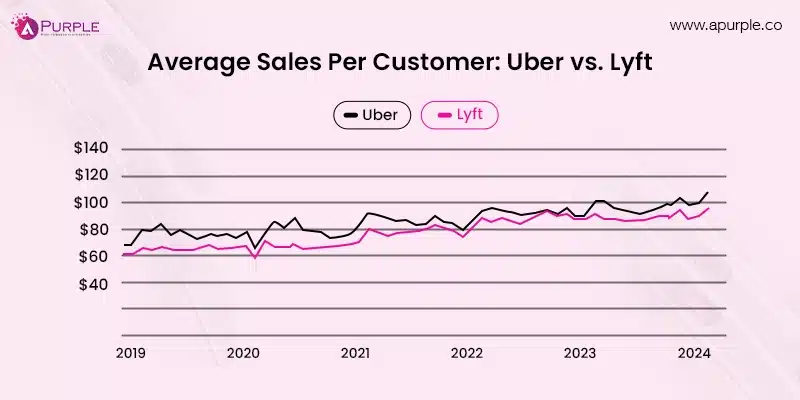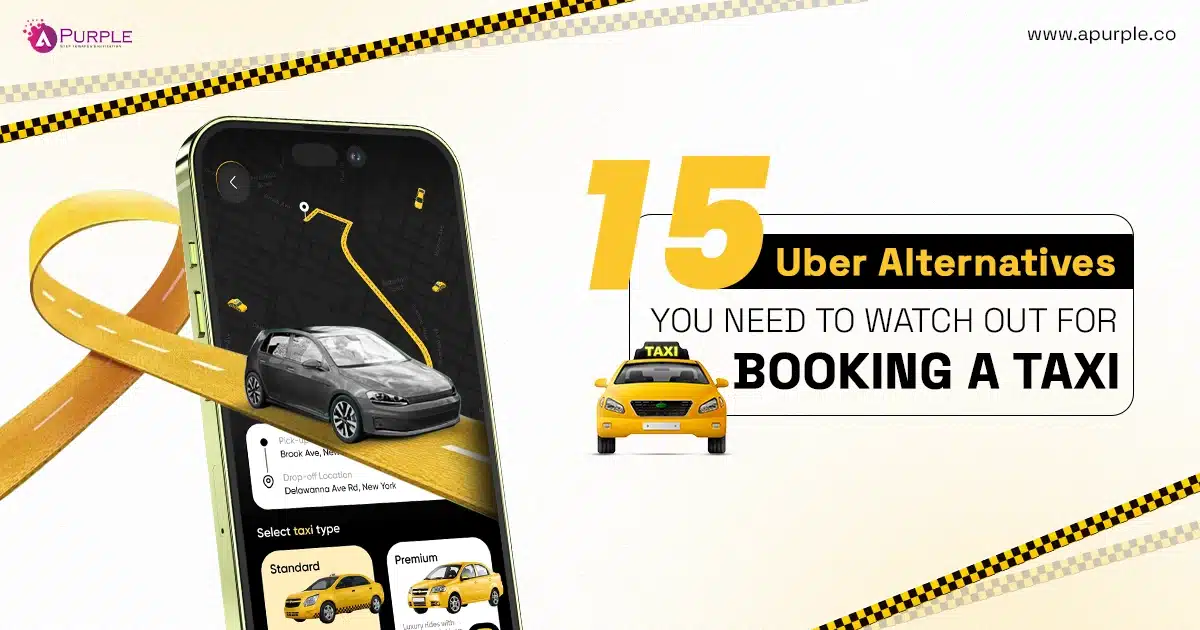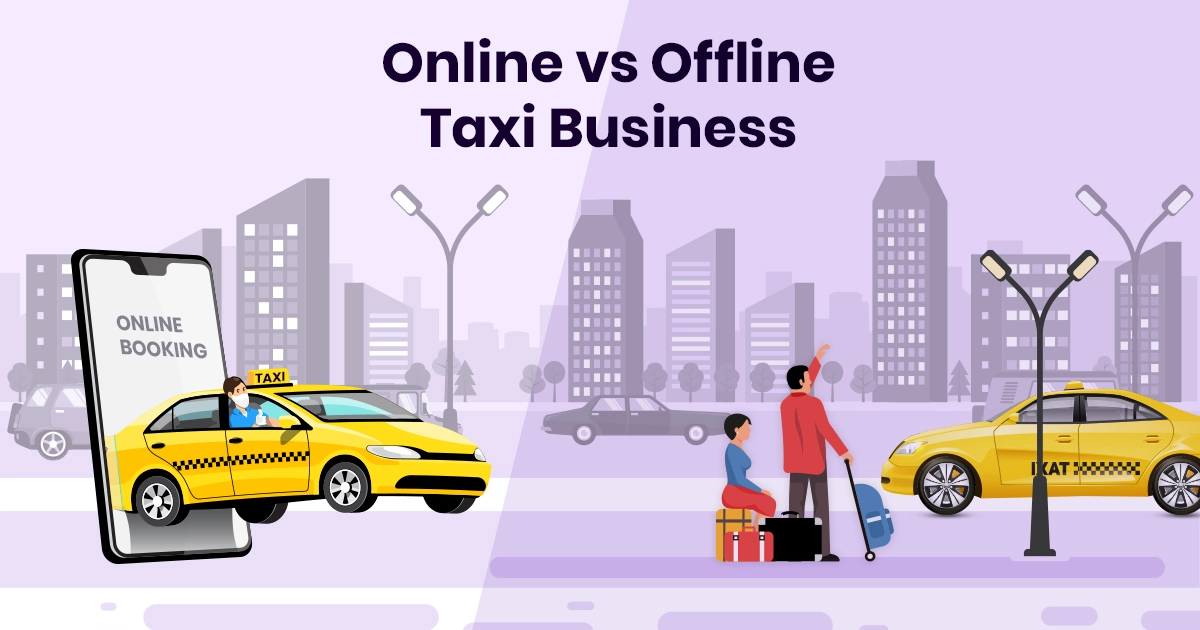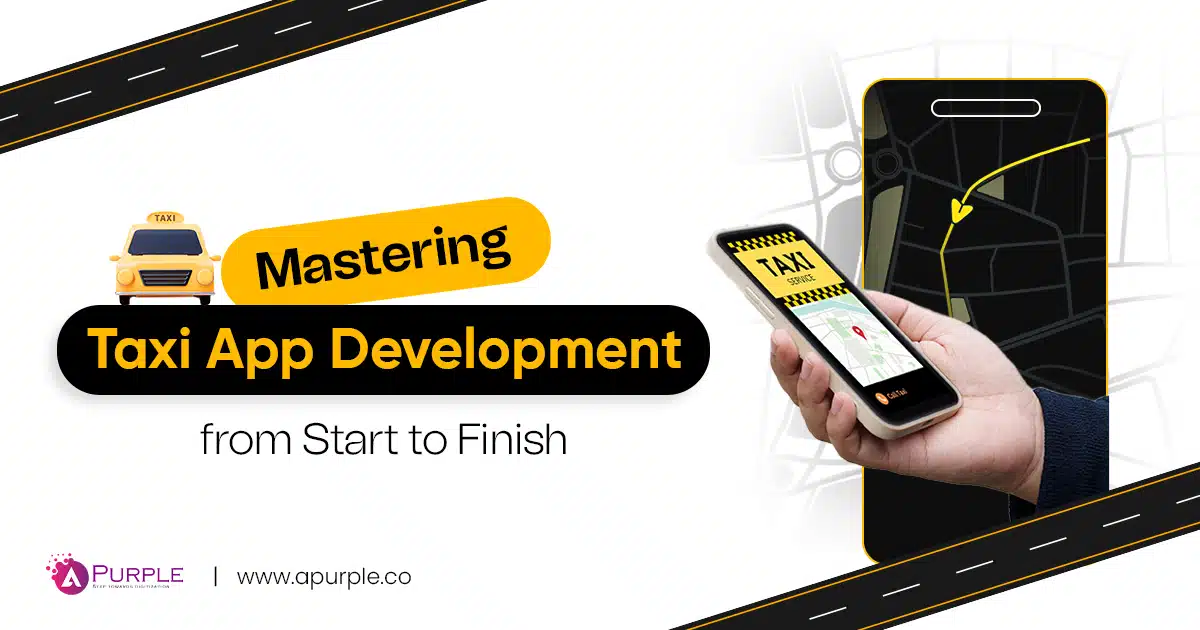Since humans invented the wheel, transportation has evolved from rudimentary carts to modern cabs. However, public transport changed forever in 1897 when Daimler Victoria’s first cab started operating in Stuttgart. Fast forward to 2026, ride-hailing apps like Uber and Lyft have revolutionized the way we book cabs, offering unparalleled convenience and accessibility.
It’s not just convenience. Both Uber vs Lyft are tough competitors in every aspect, including ease of booking, prices, ride quality, and type of services.
However, you can’t take rides on two apps simultaneously (of course, you can if you are more than one!)
So, which one to choose then?
The debate over which is better between Uber vs Lyft can be complex, with multiple perspectives to consider:
- User perspective: Provides a clear roadmap of key steps.
- Driver perspective: Analyzing maximum revenue generation potential.
- Entrepreneur perspective: Understanding business models for those looking to create similar apps.
To simplify this comparison, our experts have thoroughly analyzed both services based on prices, market share, app experience, and business models with the latest data.
Uber vs Lyft: An Overview
Uber was the first to introduce ride-hailing ease to the world with its on-demand service in 2009. Since then, Uber has seen growth like no other on-demand app. With rapid growth across Mobility and Delivery services, Uber operates in all US states and over 70 countries worldwide. The platform is strategically expanding into new regions, aiming to serve over 16,000 cities by the close of 2026.
On the other hand, Lyft first launched in San Francisco in 2012 and entered the ride-hailing app scene. In January 2013, It raised $15 million in Series B funding and expanded its services to Los Angeles.
Lyft gradually expanded to more than 60 cities by April 24, 2014. Currently, Lyft operates across 46 US states and 12 Canadian cities, with a presence in approximately 644 US cities and towns. However, when comparing Lyft vs. Uber in terms of global operations, Uber clearly has the upper hand!
Uber has a better reach for a worldwide audience, making it more experienced in delivering the services you need! But does that reflect on their sales, too?
Lyft vs Uber – Sales Per Customer
Knowing the sales per customer will allow you to understand why these ride-hailing apps are a preferred choice for customers. Uber’s average monthly sales per customer are projected to surpass $135 by 2026, driven by a 9% growth rate over 2025 figures. This consistent acceleration shows the platform’s strong customer spending growth over recent years.
At the same time, Lyft’s average sales per customer are projected to reach $105 by 2026, representing an estimated 5% growth over the preceding year. This steady increase continues to reflect Lyft’s measured, deliberate growth pattern compared to its primary competitor.
These sales data provide insight into which ride-hailing application is driving more revenue, which may seem attractive as a business proposition. The gap between the two platforms is projected to widen further, with Uber generating approximately 29% more revenue per customer than Lyft based on 2026 projections. However, there are intricacies of taxi app development that you need to know before developing a taxi app.
Must Watch Podcast Before Developing a Taxi Application:
But, it’s crucial to understand that better revenues and sales per customer have much to do with the well-defined business model.
Uber’s Core Business Model
Uber’s business model is based on a mediator approach. It creates a digital platform that acts as a mediator between riders and drivers, while continuously expanding its ecosystem to include food delivery, freight, and other services.
The entire operation is powered by dedicated apps for riders and drivers and a centralized panel for admins. Uber’s sophisticated matching algorithm has evolved beyond just finding the nearest driver, now incorporating factors like driver ratings, estimated time of arrival, and even driver earnings goals. Riders place the request from the dedicated app, and drivers fulfill it by accepting the ride request.
This has led to a new business model called “UberX.” It is a model that many startups are now looking to build an app like Uber for various on-demand services. By 2026, this model has been further enhanced with additional revenue streams from autonomous vehicle partnerships and expanded delivery services, creating a more diversified business approach that many startups aim to replicate.
Looking for a Lyft clone script? Check out our Lyft clone app development
Lyft’s Business Model
There is no stark difference between Lyft vs. Uber’s business models. Like Uber, Lyft is a mediator that helps riders and drivers connect through its platform.
Initially, there was a difference between the two ride-hailing apps, as Lyft’s business model only focused on carpooling services. However, Lyft’s team pivoted to shorter urban rides for more revenue.
Riders can now easily book cabs on the app with Economy, Premium, and Lyft XL options. Like Uber, Lyft allows customers to book rides Using a dedicated application. Drivers are notified and can accept or reject the request.
So, if both apps use the same business model, do they offer services at the same price?
The answer is “No!”
Lyft vs.Uber: Pricing Comparison
There will be some stark differences if you compare Uber vs. Lyft prices. For example, in 2026, the average Uber fare will be around $29.50 in the US, while the average Lyft fare is estimated to be approximately $24.25.. However, this scenario changes from city to city as there are differences in base fare.
For example, Uber is projected to charge $1.25 per mile in Chicago and $2.10 per mile in Dallas throughout 2026.Fares also change based on specific regions. So, if you ride to suburban areas, the average fare can range between $18 and $40, reflecting the 7.2% year-over-year increase in rideshare prices reported across major platforms.
Lyft, on the other hand, charges a standard base fee of $1.10 per ride in over 640 metropolitan cities. However, for the more luxurious service, “Lyft Lux,” is projected to reach $4.50 per ride in 2026.
Uber may seem costly regarding average fare, but Lyft also has higher prices in some urban areas. The Uber vs. Lyft price comparison remains a close call through 2026, with Lyft typically offering slightly lower base fares. However, Uber’s dynamic pricing provides more flexibility and diverse ride options during off-peak hours, giving it a strategic edge.
Now that you know the difference between Uber and Lyft prices, it’s time to understand who is leading the market!
Market Share Insights of Uber and Lyft
When you compare Lyft’s market share to Uber’s, you can see Uber’s leading position continues in 2026. Uber dominates the rideshare market in the US with approximately 55% of the market. Lyft currently holds about 31% of the US market, a slight decrease from 35% in previous years as autonomous vehicle services begin to capture a portion of the market.
A significant reason behind Uber’s sustained success is its diversified service portfolio, which extends from ridesharing apps to Uber Eats and expanded delivery services for alcohol, groceries, and packages.For 2026, Uber is projected to generate $27.5 billion from Mobility services and $15.2 billion from Delivery services. Lyft continues to focus primarily on ridesharing and cab booking services, though it has begun exploring partnerships with healthcare providers and businesses. For a better understanding, here is an updated comparison of Uber vs. Lyft services.
Types of Services That Uber and Lyft Provide
When you compare the types of services that Uber and Lyft offer, Uber does offer more services.
| Service Category | Uber | Lyft |
|---|---|---|
| Standard Ride Booking | UberX: The standard service, offering rides in everyday cars. | Lyft Standard: Compared to UberX, Lyft provides rides in regular cars. |
| Large Vehicle Service | UberXL: Larger vehicles for groups of up to six passenger, now with premium vehicle options. | Lyft XL: Larger vehicles for groups, with improved vehicle selection process. |
| Comfort Rides | Uber Comfort: Enhanced comfort with newer cars and more legroom. | Lyft Lux Black XL: Luxury SUVs for larger groups. |
| Premium Rides | Uber Black: Premium black car service with professional drivers. | Lyft Lux Black: High-end luxury rides. |
| Luxury Rides | Uber Lux: Luxury rides in high-end vehicles. | Lyft Lux: Premium black car service. |
| Car Pooling | Uber Pool: Shared rides with other passengers heading in the same direction. | Lyft Shared Rides: Shared rides with other passengers. |
| Food Delivery | Uber Eats: A Food delivery service. | N/A |
| Freight Management/Logistics | Uber Freight: Freight and logistics services. | N/A |
| Scooter Rentals | Uber Bike and Scooter Rentals: Environmentally friendly options for short trips. | Lyft Scooters and Bikes: Short-distance rentals for bikes and scooters. |
| Healthcare Transportation | Uber Health: Non-emergency medical transportation services. | Lyft Healthcare: Expanded healthcare partnerships for medical appointments transportation. |
The above comparison between Uber vs. Lyft provides an insight into what services riders can expect. But if you are a driver, commission charges and compensation matters the most.
Driver Compensation and Benefits
If you are a driver working with either of the two ride-hailing services, understanding the Uber vs Lyft compensation difference is crucial. It allows you to maximize your revenue and know which app is worth accepting rides on.
In 2026, an Uber driver is projected to make between $27-$42 per hour across major U.S. cities, while a Lyft driver is estimated to earn slightly less at $24-$37 per hour. Full-time Uber drivers can earn between $30,000 and $60,000 annually. So, Uber continues to offer higher potential earnings than Lyft in most markets.
But what about other perks and benefits?
Here is a comprehensive comparison of drivers’ different perks with Uber and Lyft!
| Perks & Benefits for Drivers | Uber | Lyft |
|---|---|---|
| Flexibility | Drivers can set their schedules and balance commitments | Drivers can set their working hours |
| Bonus and Incentives | Bonuses and promotions for driving during peak hours | Drivers bonuses and earn reward points during busy hours and unlock pricing tiers for better earning |
| Cashback on Gas | N/A | Drivers get cashback on fueling by completing a specific amount of rides |
| Access to Wellness Perks | N/A | Lyft provides a debit card facility that allows drivers to have wellness perks |
| Community Stories | N/A | Lyft’s driver blog allows drivers to share stories, details of local events and other updates |
User Experience For Uber and Lyft
This comparison covers many aspects, from Uber vs. Lyft’s cost to compensation and market share. However, it will be incomplete without comparing user experience for both ride-sharing apps.
While Uber and Lyft’s core app experiences remain similar in 2026, both have made significant enhancements to differentiate their platforms. Uber has improved its interface with more intuitive navigation and integrated services like Uber Eats directly into the main app. Lyft has focused on simplicity and personalization, with customized ride suggestions based on user habits. Both continue to use dashboard identification technology – Uber’s updated Beacon 2.0 now displays rider names in multiple colors, while Lyft’s next-generation Amp includes improved visibility and personalized greetings.
The dedicated rider app also provides live ride tracking, instant communication with drivers, and fare estimation. While these may seem basic features, replicating them requires an analysis of Uber app development costs. The cost may be higher depending on the complexity of the feature.
As a user choosing between the two ride-sharing apps for your ride bookings solely based on app experience may seem complex. However if you consider all the factors compared above like pricing, types of services, app experience and market share, the choice becomes a little easier!
Future Outlook and Innovations for Uber and Lyft
By 2026, both Uber and Lyft have accelerated their innovations, particularly in autonomous vehicles and sustainability initiatives.
Uber has announced plans to deploy autonomous fleets in select cities by 2026, partnering with leading autonomous vehicle companies. Its super app strategy has advanced significantly, now including seamless integration of ride booking, food delivery, package shipping, and public transit ticketing in one platform. Uber’s sustainability commitments have expanded, with the $800 million Green Future program helping drivers transition to electric vehicles and a commitment to be zero-emission globally by 2040.
On the contrary, Lyft is targeting the initial deployment of driverless vehicles in 2026 and continues to progress toward its 100% electric vehicle goal by 2030. Its Green Mode has expanded to 22 cities and 40 airports, allowing riders to specifically request electric or hybrid vehicles. While maintaining its focused approach rather than pursuing super app status, Lyft has deepened its strategic partnerships in healthcare transportation and expanded its bike and scooter sharing services in major urban centers.
Uber vs. Lyft: It’s Verdict Time!
In 2026, Uber maintains its competitive edge over Lyft, though the gap has narrowed in certain aspects. When evaluating operational capabilities, global reach, service diversity, and market share, Uber clearly excels. With approximately 55% of the US market compared to Lyft’s 31%, Uber’s dominant position continues, bolstered by its expanding international presence across 70 countries and 15,000 cities. Uber’s average customer spending of $115 per month also outpaces Lyft’s $98, reinforcing its revenue advantage.
However, the choice between ride-hailing applications continues to depend on multiple factors including location, specific needs, and personal preferences. Both have regions where they compete, but for a user, choosing the best depends on localized services. The choice will differ if Uber is better in one area and Lyft in another. Uber is the ideal choice for drivers, but again, it depends on how many perks each ride-hailing app offers in specific regions.
But if you are a business looking to build apps like Uber or Lyft, you need experienced taxi app development services. Contact us now to learn more about on-demand development services.
FAQs
Uber and Lyft have tipping policies. Uber riders can tip in cash or before the trip ends, while Lyft allows tipping within 72 hours of the trip. Uber has faced criticism for driver pay, while Lyft has been accused of deducting money from drivers for driving on interstate highways.
Lyft allows tipping within 72 hours, while Uber accepts cash tips or tipping before the trip ends. Uber is available in more cities globally, while Lyft offers greater transparency in trip receipts.
Yes, as long as they meet city requirements for insurance, background checks, and minimum ages.





